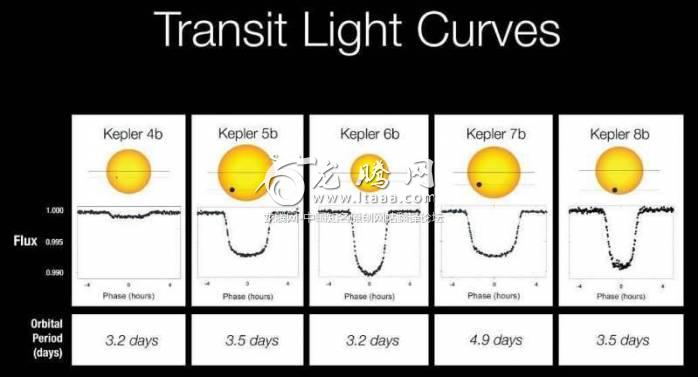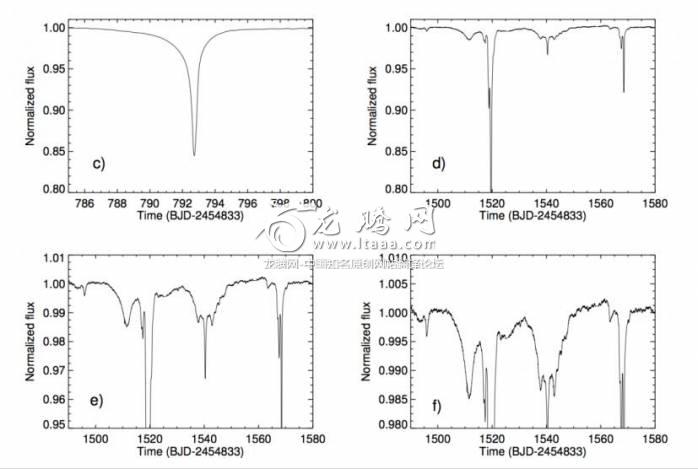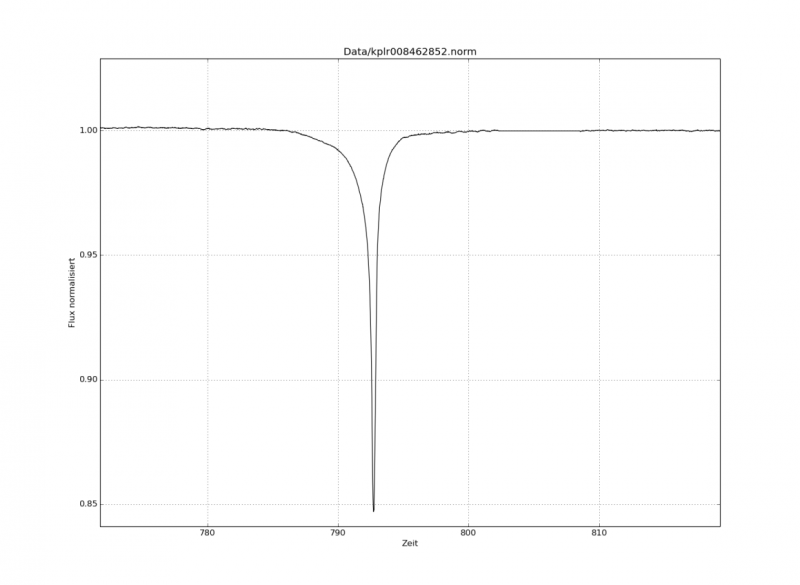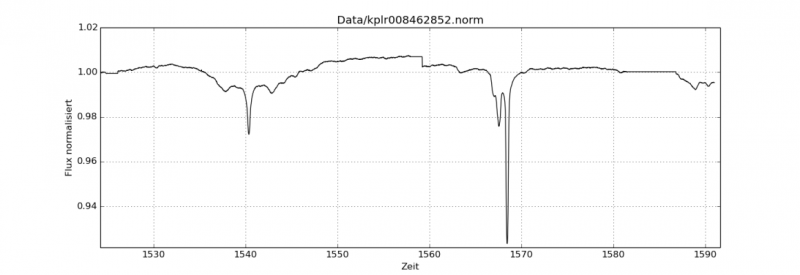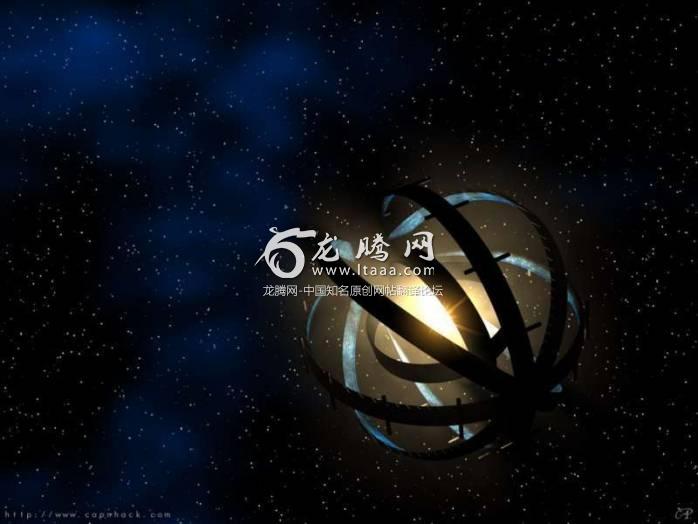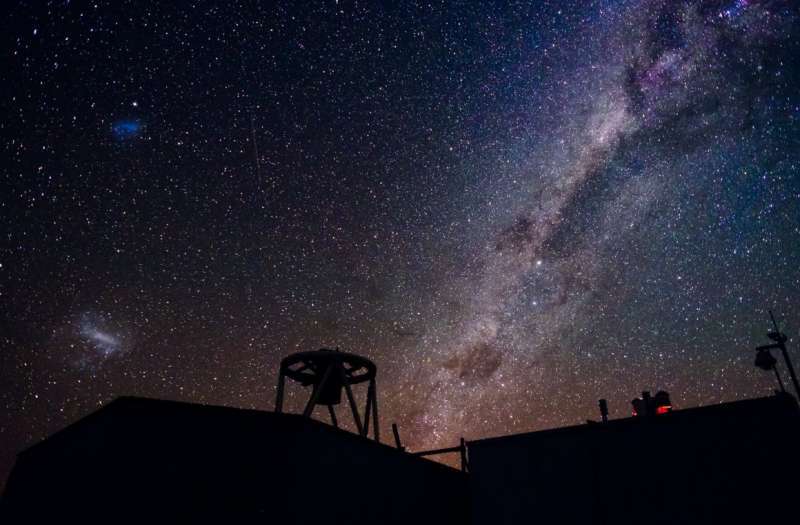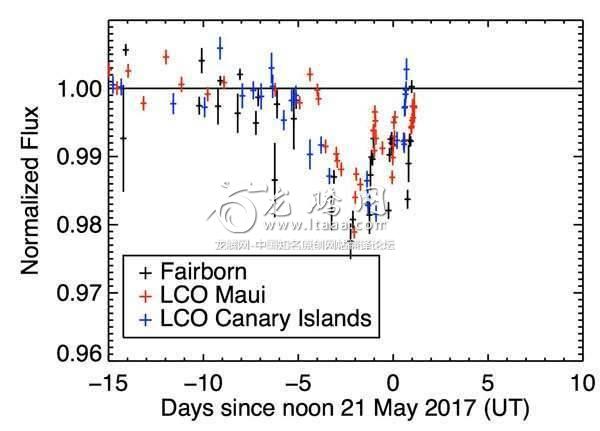什么鬼:我们已知的最怪异恒星的故事 [美国媒体]
很明显有什么神秘的事正在发生。我们不知道究竟发生了什么,或者它是如何发生的,但是我们与真相之间的距离跟我们在2009年时的一样。在2009年5月,世界上有几百名观察者发现了一颗处在非常非常遥远星系的恒星。这颗恒星看起来跟他们之前看过的没什么不同。这几百人聚集在一个名叫行星猎手的网络论坛——该论坛是公民科学计划的一部分——狂热地讨论着他们的发现......
WTF: The Story of the Strangest Star We’veKnown
什么鬼:我们已知的最怪异恒星的故事
BY SANDHYA RAMESH ON 20/09/2017
There’s clearly something mysterious goingon. We don’t know what it is or how it works and we’re as close to figuring itout as we were in 2009.
很明显有什么神秘的事正在发生。我们不知道究竟发生了什么,或者它是如何发生的,但是我们与真相之间的距离跟我们在2009年时的一样。
An artist’s impression of Tabby’s star.Credit: NASA/Wikimedia Commons
艺术家想象中的塔比星。图片版权:NASA/Wikimedia Commons
Sandhya Ramesh is a science writer focusingon astronomy and earth science.
Sandhya Ramesh是一名关注天文学和地球科学的科普作者。
In May of 2009, several hundred peoplearound the world noticed a star in a galaxy far, far away. It looked likenothing they’d ever seen before. They thronged to discussion forums on the webfor the citizen science project called Planet Hunters and frantically discussedwhat they were seeing. They’d all been working on data obtained by the KeplerSpace Telescope. The star, later called KIC 8462852, was blinking in a verystrange way.
在2009年5月,世界上有几百名观察者发现了一颗处在非常非常遥远星系的恒星。这颗恒星看起来跟他们之前看过的没什么不同。这几百人聚集在一个名叫行星猎手的网络论坛——该论坛是公民科学计划的一部分——狂热地讨论着他们的发现。他们都在研究开普勒太空望远镜获得的数据。这颗后来被叫做KIC8462852的恒星正在以一种非常怪异的方式闪烁着。
Hunting for planets outside the SolarSystem is an active field of astronomy today. The first exoplanet wasdiscovered in 1992. Only 25 years later, there are more than 3,500 confirmedplanets orbiting stars other than our own. NASA’s Kepler Space Telescope alonewas responsible for finding over 2,000. It did so by watching the stars in apatch of the sky for weeks, months or even years at a time. When a planet thatgoes around one of these stars crosses against the face of its star, it casts asmall but definite shadow in the starlight. These shadows are recorded and canbe used to calculate the size of the planet. The larger the planet, the morelight it blocks.
在今天,寻找太阳系以外的行星是天文学中的一个活跃领域。第一颗系外行星于1992年被发现。仅仅25年后,已经有超过3500颗系外行星被确认。其中,NASA的开普勒太空望远镜独自发现了超过2000颗。开普勒太空望远镜的工作方式是对宇宙某一部分持续观察几周、几个月甚至几年。当有行星掠过这些恒星表面时,对恒星亮度会产生微小但明确的干扰。这些干扰会被记录下来,用来计算行星的尺寸。越大的行星遮挡的光越多。
The resulting database is hundreds ofterabytes large, so astronomers use finely tuned computer-programs to siftthrough it looking for the telltale signs of an exoplanet. The programs aremore efficient and can process information much faster than a team ofastronomers ever could. But they aren’t perfect either. Sometimes, the programsmiss things that they haven’t been taught to look for. So enter citizenscience.
这些记录数据有几百TB之多,所以天文学家使用精确设定好的电脑程序来筛选这些信息,以寻找系外行星的踪迹。这些程序非常有效率,比以往任何天文学家团队处理信息的速度都要快得多。但是它们也并不完美。有时候,这些程序会忽略掉它们没有被规定寻找的东西。这时就需要公民科学了。
Students, homemakers, artists, grandparentsall contribute to citizen science projects in myriad ways. There are projects thathelp look through camera trap pictures to identify animals. Projects where youand I can look at images of the Martian surface to identify wind patterns, atscanned manuscripts and digitise text, even create a database of wildlife. Thehuman brain is very good at recognising patterns – so much so that we even seepatterns where there might not be any.
学生、家庭主妇、艺术家、老爷爷老奶奶都能够以不计其数的方式对公民科学项目做出贡献。有的计划是帮助识别由隐蔽相机拍下来的动物。有些项目是让你我通过查看火星表面的照片来确认风型,有些是扫描手稿制作电子版文档,甚至还有建立野生动物数据的项目。人类大脑非常善于识别图案——以至于有时候我们甚至能看到本不存在的图案。
Planet Hunters is a citizen science projectto help identify dips in the brightness of stars that computers could havemissed. As of August 2017, over 300,000 citizen scientists access it and combthrough Kepler data every day.
行星猎手就是这样一个公民科学项目,旨在帮助科学家识别被电脑遗漏的恒星亮度干扰。截止到2017年8月,已有超过30万公民科学工作者参与其中,每天都在梳理着开普勒太空望远镜传回的数据。
In June 2009, astronomer Tabetha Boyajianwas alerted by a number of citizen scientists that a particular star about1,500 lightyears away was being consistently flagged by users as “interesting”and “bizarre.” Then a postdoc at the University of Yale, Boyajian and hercolleague Debra Fischer, who founded Planet Hunters, were hooked. The star theywere looking at did look like an anomaly. Its brightness initially dipped by atiny 0.5% – which was normal – but it lasted for four days, which is totallynot normal. Typically, planets that cross the path of stars like these tend tohave dips that last only a few hours.
在2009年6月,天文学家Tabetha Boyajian收到一群公民科学工作者的警报,称有一颗大概1500光年以外的独特恒星一直在被用户们贴上“有趣”或者“怪异”的标签。作为耶鲁大学的博士后,Boyajian和她的同事Debra Fischer——行星猎手项目的发起人——被这个情况吸引住了。这颗恒星的确看起来十分不同。它的亮度一开始减弱了微小的0.5%——这很平常——但整整持续了四天,这就完全不平常了。一般来说,行星掠过类似恒星的表面形成的亮度干扰大概只会持续几个小时。
That was the first dip in brightness theynoticed in the data, in early 2009. Following this, a few weeks later, thebrightness of KIC 8462852 dipped for almost a full week. Boyajian and Fischerspent days poring over the data and running through numbers, but the behaviourof KIC 8462852 couldn’t be explained away. The instruments were working fine,the computers were working fine, the data was clear. The dips were real – andinexplicable. And not only were there long periods of dimming, they were alsoweird kinds of dimming.
这就是在2009年早些时候他们注意到的第一次亮度干扰。在几个星期之后,KIC8462852的亮度减弱持续了几乎整整一周。Boyajian和Fischer花了几天时间研究数据浏览数字,但仍不能解释KIC8462852的表现。仪器工作正常,计算机工作正常,数据清楚。亮度减弱的确存在——但无法解释。不仅亮度减弱的超长周期显得非常奇怪,亮度减弱的方式也非常奇怪。
When a planet passes in front of a star,because of its near spherical shape, it creates a symmetric dip as it crossesagainst the disc of the star. The way the brightness dropped on a graph wasalso the way it picked up (see image below).
当一颗行星掠过恒星表面时,其类似球形的形状会引起对称的亮度变化。在统计图上显示的亮度减弱模式应该跟亮度恢复模式一致(参见下图)。
Credit: NASA/Kepler Mission
图片版权:NASA/Kepler Mission
But the dips Kepler spotted with 8462852were asymmetric.
但是开普勒望远镜观察到8462852的亮度减弱模式却是不对称的。
Credit: T. Boyajian & team/MNRAS
图片版权:T. Boyajian & team/MNRAS
Planets also orbit their stars in fixedperiods of time, and they reappear after exactly the same amount of time duringeach dimming event. But whatever was moving around KIC 8462852 was causing thestarlight to dim unpredictably, randomly.
行星以固定周期围绕恒星旋转,它们引起的亮度干扰之间的时间间隔非常精确。但是围绕着KIC8462852旋转的物体引起的亮度干扰却无法预测,非常随机。
Citizen scientists and astronomerscontinued to study the star, which had returned to its regular brightness.
公民科学工作者和天文学家持续研究这颗恒星,现在它已经恢复了正常亮度。
Two years later, in March 2011, Keplerrecorded a new dip in the brightness of KIC 8462852 and sent astronomers into atizzy. A large planet the size of Jupiter records about 1% dip in its star’sbrightness, at most. But the brightness of KIC 8462852 had dipped by nearly15%. Like in 2009, the dip was again asymmetric, and lasted a week beforeslipping back to normal. This pattern repeated for a few days and then the starwent ‘silent’ again.
两年后,在2011年3月,开普勒望远镜捕捉到了KIC8462852新的亮度干扰,让天文学家再度紧张起来。一颗像木星那么大的行星最多能够引起恒星亮度减少1%,而KIC8462852的亮度减少了近15%。就像在2009年一样,亮度干扰不对称,持续了一个星期才恢复正常亮度。这个模式重复了几天,之后这颗恒星又“安静”了。
Strong reduction of light from KIC 8462852in March 2011 (day 792 of Kepler observations). Credit: JohnPassos/WikimediaCommons, CC BY-SA 4.0
KIC8462852在2011年3月发生的亮度急剧降低(开普勒望远镜观测第792天)。
图片版权:JohnPassos/Wikimedia Commons, CC BY-SA4.0
In February 2013, and later in April, KIC8462852 woke up once more. This time, it threw up a very irregular series ofdips. While previous patterns involved simple dips in brightnesses at randomintervals, the new data implied that its brightness was shifting in bothintensity and, now, duration. The dip patterns were complicated as well.Astronomers spotted smaller dips within bigger dips, and even smaller oneswithin them. This fractal flux of its brightness was repeated across many days,as well as in the form of irregular recursions within the same dataset, whichitself was becoming quite complex. At one point, the star’s brightness dippedby a stunning 22%.
在2013年2月和4月,KIC8462852再次苏醒。这次的一系列亮度干扰完全无规律可循。之前的亮度干扰仅仅是一些随机时间间隔的亮度减弱,新的数据显示它的亮度的强度和持续时间都在变化。干扰模式也非常复杂。天文学家在大的干扰中观测到了小的干扰,在小干扰里甚至还有更小的干扰。其碎片化的亮度变迁在一些天内不断重复,同时还伴有不规则的亮度恢复,让亮度干扰变得极其复杂。在某一时刻,该恒星亮度令人震惊地减少了22%。
The February 2013 dip. Credit:JohnPassos/Wikimedia Commons, CC BY-SA 4.0
发生在2013年2月的干扰。图片版权:JohnPassos/Wikimedia Commons, CC BY-SA 4.0
The April 2013 dip. Credit:JohnPassos/Wikimedia Commons, CC BY-SA 4.0
发生在2013年4月的干扰。图片版权:JohnPassos/Wikimedia Commons, CC BY-SA 4.0
In October 2015, Boyajian and her teampublished a paper with her team, titled ‘Where’s The Flux’, that set off a media frenzyand brought the star within the astronomy world’s spotlight. Ever since, KIC8462852 has been called Tabby’s star, Boyajian’s star and – quite aptly – theWTF star.
在2015年10月,Boyajian和她的团队一起发表了一篇论文,标题是《光通量都去哪了》(Where’sThe Flux)。这篇论文引起了媒体的疯狂追捧,并让这颗恒星成为天文学界的焦点。从那以后,KIC8462852被称为塔比星、Boyajian星或者——非常形象——什么鬼星(WTF star)。
Things that cause stars to dim have veryspecific signatures depending on their physical properties. This kind of datais usually found in the light that the star emits. If it was a cloud of dustblocking it, it’d be blocking more blue light than anything else. If somethingmore solid and ample was in the way, it would be blocking light of allwavelengths. Solid objects would also heat up and glow in the infrared data.Another kind of heating, so to speak, can also reveal what the object is madeof. Some elements absorb certain frequencies of starlight, which would show upas blanks in the recorded data. This barcode of sorts can be used to ID groupsof elements.
对恒星亮度造成干扰的物体通常会因其物理属性产生具体的特征。这种数据通常可以在恒星本身发出的光亮中找到。如果是一团云或烟尘挡住了恒星,大部分蓝光会被阻挡。如果遮挡物更加密实且数量众多,所有波长的光都会被阻挡。密实物体也会被加热,在红外数据中非常明显。另一种加热——姑且这么讲——可以显示该物体的构成。一些元素会吸收相应频率的星光,因此在数据中会显示该波段光线缺失。这种条码可以用来测定元素群。
Using their spectroscopic tools,astronomers were able to deduce that Tabby’s star was a middle-aged starburning just like our 4.5-billion-year-old Sun (in technical parlance, anF-type main-sequence star).
天文学家使用光谱分析设备可以推断出,塔比星是一颗中年恒星,年龄跟我们45亿岁的太阳差不多(用专业术语来说,属于F型主序列恒星)。
In light of all this information, Boyajianand her team offered a few scenarios in 2015 that could explain what might becausing the mysterious dimming.
鉴于此,Boyajian和她的团队在2015年提出了一系列假说来解释神秘干扰的成因。
On top of the list – and to no one’s surprise– was a protoplanetary disc. A star system forms when a giant cloud of gascollapses under the weight of its own gravity and starts to spin around. Whenthat happens, all the material spreads out like a disc, spinning faster. It isdensest at the centre, where the system’s host star will eventually form, whilethe light stuff – gases and some rocks – are flung outward. This is theprotoplanetary disc. It’s where planets are born. Clumps of material collidehere and there, forming bigger clumps that then snowball into planetesimals.The gases that are expelled further out of the disc form the distinctlyspectacular yet bottomless gas giants.
排名最靠前——也不出乎大家意料——的解释是存在一个原始行星盘。恒星系的产生源于一片巨大气体云因其本身质量而坍缩并开始自转。这时,所有物质组成了一个圆盘,加速旋转。在圆盘中心部分密度最大,恒星也会最终在这里产生,而小质量物质——气体和一些岩石——会被甩到外侧。这就是原始行星盘。这是行星的出生之地。一团团的物质到处碰撞,形成更大的团块,像滚雪球一样变成微行星。气体被抛出星盘,形成绚丽且深不见底的巨大气体云。
The protoplanetary disc revolves around astar for millions of years before a stable planetary system can come to be. Inthis time, the disc can cause irregular dips in the star’s brightness (as seenby a distant observer).
原始行星盘会围绕恒星旋转上百万年,最终产生稳定的行星系。在这段时间,原始行星盘会对恒星亮度产生不规则干扰(在远距离观察者眼中)。
But there was one big hole in this theory:protoplanetary discs, by virtue of being ‘proto’, exist only around newbornstars. Tabby’s star isn’t newborn.
但这个理论存在一个巨大的漏洞:原始行星盘,之所以被“原始”修饰,就是因为它只存在于新生恒星周围。塔比星不是新生恒星。
Moreover, dust absorbs heat. When itbecomes even mildly hot, say to the temperature of the human body, it startsglowing in the eyes of an infrared telescope. But NASA’s Spitzer telescope sawno such thing. It also ruled out ideas like two planets colliding and trashingtheir orbits with rocks or a planet being blown apart in an intergalactic spacebattle. In fact, it seems there’s just no debris around Tabby’s star.
另外,灰尘会吸收热量。当它稍微有点热,比如说,跟人类体温一样时,红外望远镜会捕捉到它的光芒。但是NASA的斯皮策望远镜没有此类发现。另外一种解释——即两颗行星碰撞导致它们的轨道上布满碎片,或者一颗行星在星际大战中被击碎——也被排除了。事实上,在塔比星的轨道上似乎并不存在碎片。
Next idea: Maybe the star itself grew insize and brightness and then shrank back down? There are several such stars weknow today. Astronomers call them variable stars. The largest star in theobservable universe, UY Scuti, is an example. They’re observed when a youngstar’s brightness and mass suddenly spike when a large amount of material fallsfrom a planetary disc into the star. But this idea was also knocked down by thesame hammer: the star isn’t young and there’s no protoplanetary disc.
下一个说法:或许这颗恒星的尺寸和亮度会自行增加和减少?目前我们知道的确有一些恒星是这样的。天文学家称这些恒星为变星。在可观测宇宙中发现的最大恒星UY Scuti就是这样的星星。它们通常会在原始行星盘中大量物质被吸入年轻恒星导致亮度和体积突然激增时被发现。但这个说法也被同样的矛攻破了:这颗恒星并不年轻,周围没有原始行星盘。
The Boyajian et al paper concluded that afamily of passing comets would be the most acceptable explanation. But it’salso unlikely: to cause the levels of dimming that astronomers were seeing withTabby’s star, a locusts’ swarm of giant comets would have had to be passing by.If they existed, they would likely have been formed when a rocky body about 100km wide was shattered in a single explosion. Comets also don’t glow in theinfrared; the ice on them absorbs the heat and sublimates into space. Asimprobable as it sounds, this was the only idea that couldn’t be knocked downright away.
Boyajian及其团队的论文总结出了可能最容易被接受的说法:一大队彗星经过恒星表面。但这也不太可能:如果要引起天文学家观察到的塔比星级别的亮度干扰,这队大彗星必须得像蝗虫群一样密集。如果这样的彗星群存在,那它们必须得是一颗100公里直径的岩石一次性爆裂形成的。彗星在红外照片中也不会发光,因为热量会被其中的冰块吸收并挥发到宇宙中。就像听起来那么奇怪,这个说法是最不会被马上驳倒的。
However, none of these ideas – as trustingas they were in natural explanations – caught the public imagination as much astwo words that emerged in a conversation between Boyajian and an astronomer atPennsylvania State University a year earlier.
然而,这些说法中没有一个——像它们试图从自然角度解释的说服力一样——比Boyajian和宾夕法尼亚州立大学的一名天文学家在一次谈话中提及的一个词那样引起公众注意。
What a Dyson bubble would look like.Credit: capnhack/Wikispaces, CC BY-SA 3.0
戴森泡可能的样子。图片版权:capnhack/Wikispaces, CC BY-SA3.0
One of the things we look for when we lookfor intelligent civilisations out there is a synthetic sign of their presence.We look for things they might’ve built or signals their machines might’veemitted. We assume that if there are aliens out there, they’ve been around forlonger than we have and lead more sophisticated lives. We think they might’veexhausted all the fuel available on their planet and are now looking elsewhere.For such a guzzler of a civilisation, what better power source to focus on thanan entire star?
当我们寻找地外文明时,我们要注意的一个证据就是他们存在的综合征兆。我们寻找他们可能建造的物体,或者他们的机器可能发射出的信号。我们假设,如果有外星人存在,他们会比我们存在得更久,并且有更复杂的生活方式。我们设想他们可能耗尽了母星上的所有燃料并开始到别处寻找资源。对于这样一个胃口巨大的文明,有什么能量来源比得上一整颗恒星?
In a paper published in 1960, the physicistFreeman Dyson described a megastructure since called a Dyson sphere. It wouldbe a supermassive shell built around a star, its insides lined with solarpanels and other devices. All the energy that the star had to give, the spherewould devour. At various stages of construction, this megastructure would belike a ring equipped with living areas and power stations, then a ‘bubble’ inthe form of multiple rings, and then the sphere itself.
在1960年发表的一篇论文中,物理学家FreemanDyson描述了一种巨型构筑物,在之后被称为戴森球。这是一种将恒星包在里面的巨大结构,其内部布满了太阳能板和其他设备。恒星产生的所有能量都会被这个球吸收。在不同建设阶段,这个结构可能会看起来像一个带有居住区和能源站的圆环,然后演变成一个由多个环组成的“泡泡”,最后变成一个球。
In 2014, John Wright, the Penn Stateastronomer was fascinated by large structures that advanced civilisations couldbuild to harvest energy. He suggested looking for a Dyson sphere around Tabby’sstar. This is why it’s also called the ‘alien megastructure’ star.
在2014年,宾州州立大学的天文学家JohnWright被一个可能是先进文明建造的吸收能量的巨大结构吸引住了。他建议在塔比星附近寻找戴森球。这也是为什么这颗星被叫做“外星巨构”星。
Like with the disc and variable star ideas,there was a hole in this one as well. A Dyson sphere, by virtue of fielding thetotal energy output of an F-type star, would have to be heating up. But thecorresponding heat signature couldn’t be found in the data.
跟原始行星盘和变星说法一样,这个解释也存在一个漏洞。一个吸收F型恒星能量的戴森球应该会发生温度上升的情况。但在数据中找不到相应的热特征。
Wright had been working on a paper aboutdetecting transiting alien megastructures with the Kepler telescope. Hetheorised that the telescope was powerful enough to distinguish betweenartificial structures like giant solar panels, ringworlds, large spacebornebeacons looking for other aliens, etc., from exoplanets. He’d written a blog post about it in 2013. When hewas in the process of turning it into a journal article, Boyajian visited PennState for a lecture and shared then-unpublished data of the dimmings withWright.
Wright正在写一篇关于用开普勒望远镜寻找外星能量输送巨构的论文。他推断道,这个望远镜足够强大到能分辨类似巨型太阳能板、环世界、为寻找其他外星文明建造的大型空间天线等人造结构和系外行星。他在2013年发表了一篇关于此理论的博文。当他正在把这篇博文修改成期刊文章时,Boyajian访问了宾州州立大学并发表演讲,她跟Wright分享了当时尚未发表的亮度干扰数据。
By the next year, Wright was captivatedenough by the strangeness of the data to book time on the Green Bank Telescope,operated by the Berkeley SETI Research Centre, to observe Tabby’s star. (SETIstands for the Search for Extraterrestrial Intelligence.)
在接下来的一年,Wright被奇怪的数据迷得神魂颠倒,他向伯克利SETI研究中心运行的绿坝望远镜预订了使用时间以观测塔比星。(SETI即地外智慧生命搜索, the Search for Extraterrestrial Intelligence)
At the same time, media hysteria wasfuelled by a paper Wright and his team finishedwriting in December 2015, about how megastructures would look, using Tabby’sstar as an example.
同时,媒体因Wright及其团队在2015年12月发表的一篇论文兴奋得歇斯底里。这篇论文是关于巨型结构可能的样式,并引用塔比星作为例子。
It didn’t take long for Wright’s measuredcomments to become sensationalised. Once every two or three weeks in 2016, aheadline somewhere in the world screamed “alien megastructure”. But while alienmegastructures could exist in theory, astronomers weren’t sold on it. Theydemanded observational proof – as was their right.
没有经过多长时间,Wright精心准备过的评论就引起了轰动。在2016年,每隔两到三个星期,在世界的某个地方就会出现一条头条新闻惊呼“外星巨构”。但尽管外星巨构能够存在于理论中,天文学家们却并不买账。他们要看到观测证据——这也是他们的权利。
They still don’t have it.
他们仍然没有得到任何观测证据。
In the time since Wright made hissuggestions, his peers have forwarded another theory – this one thankfully morenatural again. Astronomers from the Universities of Valencia and Cantabria,both in Spain, asked: What if the cause of the dimming was one large, massiveplanet with orbiting companions called trojans?
在Wright给出了他的建议的时候,他的同辈们在发展另一个理论——感谢上天,这个理论更自然。瓦伦西亚大学和坎塔布里亚大学——两所西班牙大学——的天文学家们问道:塔比星的亮度干扰是否可能是一个巨型行星及其被称为“木马”的伙伴引起的?
Trojans are rocky bodies that orbit a starin the same orbit as a planet but at a different point. So for every planet,there are two areas in its orbit (before and after) where smaller bodies canpark themselves. In some of these areas, the gravitational effects of the starand the planet would cancel out, leaving the body not moving in the orbit asmuch as moving with the orbit itself. In other words, this object – a trojan –would be at the same relative position as seen from the star or the planet.
“木马”是一些跟行星处于同一轨道上围绕恒星旋转的岩石体,但意义并不同。对于每颗行星来说,其卫星轨道有两个区域(前区和后区)可以供卫星停留。在这两个区域的一些地方,恒星和行星的引力互相抵消,造成在此处的卫星几乎不沿着卫星轨道运行,反而是随着卫星轨道运行。总之,这种物体——“木马”——在恒星或行星上观测到的相对位置总是不变的。
The Spaniards simulated models of ringedplanets and trojans. “We aim at offering a relatively natural solution,invoking only phenomena that have been previously observed, although perhaps inlarger or more massive versions,” they wrote in a June 2017 preprint paper.
西班牙人建立了有环行星和木马模型。“我们旨在提供一种相对自然的解释,只援用之前观测到的现象,尽管可能以一种更大的形式出现,”他们在一篇发表于2017年6月的预印本论文中写道。
What if there really was a planet fivetimes the size of Jupiter with numerous trojans on either side? According tothe model simulated by the scientists, first some Trojans pass in between thestar and us, causing intermittent and irregular dimming. Then, when this planetpasses in front of its star, we first see the rings blocking the starlightdimly, followed by the planet creating a huge dent in the brightness, and thenthe rest of the rings pass by. Then, after 700 days, we see the trailingtrojans. This, the scientists say, could explain the relatively smooth dipcaused by a planet and then the series of sudden jagged, nested dips caused bythe trojans.
如果真的存在一颗比木星大五倍而且被众多木马环绕的行星呢?根据科学家建立的模型,首批木马经过恒星和我们之间,造成间断和不规则的干扰。之后,当行星经过恒星表面时,我们首先看到行星环模糊地遮挡了星光,随后是行星,造成恒星亮度的显着下降,然后是另一部分行星环经过。再过大概700天,我们看到了后续的木马。科学家们说,这就可以解释由行星造成的相对平滑的干扰和由木马造成的一系列波动起伏且互相嵌套的干扰。
If the model is anything to go by, thesupergiant planet will have an orbital period of 12 years. And as thingscurrently stand, those interested can expect to see the effect of trojans(assuming they’re there) on the light from Tabby’s star in 2021, followed bythat of the planet itself two years later.
如果这个模型能够成立,那么这颗巨型行星的轨道周期应该是12年。根据现有的假说,人们应该能在2021年观测到木马(如果它们存在的话)对塔比星亮度产生的干扰,再过两年将能够看到行星产生的干扰。
The idea of a ringed planet is particularlycaptivating to scientists, it seems. Another pre-print paper earlier this month made the same claim:maybe a planet with rings can explain the phenomenon…
看起来这个有环行星的概念格外吸引科学家。另一篇本月初刊登的预发表论文给出了相同的论断:或许一个有环行星可以解释这种现象……
However, a ringed planet would stillprovide a consistent dimming pattern – something we haven’t yet seen.
然而,即使一颗有环行星仍然可以提供一种稳定的干扰模式——但是我们并未观测到这一模式。
Starting late 2015, the SETI Institutebegan looking for signs of extraterrestrial intelligence from the direction ofTabby’s star. Specifically, the institute pointed the Allen Telescope Array inCalifornia in the star’s general direction hoping to pick up on radio wavesencoded with information that would betray the hand of an alien intelligence.The odds of actually picking up on a signal were poor. Tabby’s star is 1,500lightyears away. Anything we detect now should’ve been emitted that many yearsago. Moreover, if the Tabbians were an advanced civilisation, beaming radiosignals into arbitrary patches of sky wouldn’t have made much sense. Theywould’ve observed us first and then sent out something intended specificallyfor us – a 3,000-year process because that’s how long radiation would take totravel back and forth.
从2015年末开始,SETI研究所开始在塔比星方向搜寻地外智慧生命的迹象。该研究所特别使用位于加州的艾伦望远镜阵列指向该恒星的大致方位,希望能够捕捉到外星智慧生命手中泄露出来的包含信息的无线电波。但是捕获类似信号的机会微乎其微。塔比星位于1500光年以外。我们现在探测到的任何信息都是许多年前发送出来的。另外,如果塔比星人真的是某种智慧生命,他们也不大会随便对着天空某个部分发射电波。他们应该会先发现我们,然后专门对我们发送出什么消息——无线电波走一个来回的时间是3000年。
Three-thousand years ago – i.e. in 985 BC –the Mauryas were ruling over most of India, and both Confucianism and Hellenismwere just starting to develop. If at all these beings were able to detect lifeon our planet, they would have observed us in the Iron Age. First, they’d havehad to calculate how long we would take to become proficient at detecting radiosignals, then they’d have to beam signals at us for years together so that oneday, someday, we’d finally turn our telescopic ears in their direction.Essentially, the chances are too low.
3000年前——比如公元前985年,孔雀王朝正统治着大部分印度领土,儒家思想和希腊化刚刚开始发展。如果这些外星人发现我们的星球上有智慧生命,他们应该会发现我们还处在铁器时代。首先,他们应该会计算出还有多久我们才能学会探测无线电信号,然后他们会持续好几年对着我们发送无线电波,这样到某一天我们开启天线对着他们的方向时,我们就能收到信号了。说实话,这种机会少到不能再少了。
The Allen array didn’t detect anythingduring its observations. Astronomers at SETI also were on the lookout for radiosignals. A smaller effort even looked forflashes of lasers from around the star.
艾伦望远镜阵列没有观察到任何东西。SETI的天文学家们也在寻找无线电信号。还有个更小的努力是从那颗恒星的区域寻找激光的闪耀。
Nothing.
一无所获。
Faulkes Telescope South, Australia, withthe Small and Large Magellanic Clouds visible in the sky. Credit: LCOGT
法奥克斯望远镜南,澳大利亚,天空中可见大小麦哲伦星云。图片版权:LCOGT
In all this time, Tabby’s Star has beensteadily dimming, with nothing blocking its light as far as we can tell. It’sfading away and we have no idea why.
塔比星正在持续变暗,而到目前为止我们并没发现有什么东西遮挡住了它。它在逐渐淡出,我们并不知道原因。
Monitoring it round-the-clock is importantif only because astronomers can pick up on the smallest clues. But for thispurpose, government-run telescopes are usually overbooked. Even if they wereavailable, their administrators don’t prefer taking on long-term observations.So Boyajian and her team have turned to private observatories – like the LasCumbres Observatory Global Telescope (LCOGT) Network. Its scopes areplaced strategically across the globe soastronomers can use them to look at an object (in the sky, not across the road)24×7. And to pay for using them for a year, Boyajian raised $107,421 througha Kickstarter campaign inMay 2016.
如果只是因为天文学家能够捕捉到最小的线索,那么24小时不间断观测是很重要的。但是这经常导致政府运行的望远镜被超额预定。即使有空缺,望远镜的管理者们也不愿意进行长期观测。所以Boyajian和她的团队转向了私人天文台——例如拉斯卡姆博斯天文台全球望远镜(LCOGT)网络。它的望远镜战略性地布满全球,使得天文学家可以用它们全时观测一个物体(在天上的,不是马路对面的)。为了支付一年的使用金,Boyajian在2016年5月举办的一次起步者大会上筹得了107421美元。
Fast forward to 2017.
时间很快到了2017年。
All the attention has brought together acommunity of amateur and professional astronomers who are constantly observing,working on and thinking about Tabby’s star. The smallest of fluctuations in itsbrightness is meticulously recorded and shared.
集合了一群业余和专业天文学家。他们一直在观察、研究和思索塔比星之谜。最微小的亮度波动都会被仔细记录下来并分享。
On April 24, an alert went out from arobotic telescope at the Fairborn Observatory, Arizona, after it noticed a dipin the star’s brightness. It was a perfectly normal statistical fluctuation andthe brightness returned to its former level in a week. But astronomers weren’t– aren’t – risking any complacency. Eternal vigilance is the official partyline.
在4月24日,亚利桑那州的费尔鲍恩天文台的一台机器人望远镜发出警报,它观测到塔比星出现亮度干扰。这是一次完美的正常波动,其亮度在一周后恢复正常。但是天文学家们没有自满。永远保持警醒是他们的行业底线。
A similar event occurred on May 14 at theMercator Telescope in Spain. Scientists there promptly contacted Boyajian, butthe data she was shown sported just another statistical variation. “In the end,it ended up being an artefact – i.e. not real,” she told The Wire.
在5月14日,西班牙的梅尔卡特望远镜观测到了一次类似事件。西班牙科学家马上联系了Boyajian,但是她收到的数据跟另一次统计变更相同。“到最后,这件事可能是人造的——比如,假的,”她在接受《线路》采访时说。
But only four days later, FairbornObservatory and the LCOGT observed another dip, a prospective dimming event. Analert went out the next day. “Fairborn and LCO saw the same borderlinedecline,” Boyajian said. “We monitored the star closely that night and soundedoff the alert when it was confirmed by two different observatories.”
但仅仅在四天之后,费尔伯恩天文台和LCOGT发现了另一次干扰,一次预料之中的变暗事件。在随后的一天警报发出。“费尔伯恩和LCO观测到了相同的边线减退,”Boyajian说。“我们在那一晚严密监视这颗恒星,并且在两个不同天文台都确认了变暗事件之后取消了警报。”
She was excited and called Wright at 4 amon May 19. Fairborn’s message said the star had dimmed by 2%. Just in case,Wright also tweeted, “ALERT: [Tabby’s star] is dipping.This is not a drill. Astro tweeps on telescopes in the next 48 hours: spectraplease!” In a few hours, a small army of astronomers around the world werelooking intently at the distant orb – whose brightness, by the way, went on todip by another 1%.
她如此兴奋,以至于在5月19日凌晨4点给Wright打电话告知这一事件。费尔伯恩的消息说恒星亮度减弱了2%。为以防万一,Wright也发了推特:“警报:【塔比星】发生干扰。这不是演习。天文学粉丝在未来48小时坚守望远镜:请进行光谱分析!”在几小时内,一小队来自世界各地的天文学家都在专心注视着这个遥远的星体——它的亮度又减少了1%。
Dozens of telescopes, like the Great Canary Telescope,booked weeks – some, months – in advance came together to observe the star. Theheavyweights joined in too, including the twin telescopes at the KeckObservatory (Hawaii), the LCOGT and the Multiple Mirror Telescope Observatory(Arizona). The Green Bank telescope continued to observe it. Even the Swifttelescope, which studies ultraviolet radiation in the universe from its perchin space, was going “WTF”.
众多望远镜——例如大加纳利望远镜——在几周甚至几个月之前就已经提前预定好观测塔比星。重量级选手也加入进来,包括凯克天文台(夏威夷)的两座望远镜,LCOGT和多镜望远镜天文台(亚利桑那)。绿坝望远镜持续观测塔比星。即使主要研究宇宙中紫外线辐射的斯威夫特望远镜也开始追踪“什么鬼星”。
This graph shows the brightness relative tothe star’s normal brightness. The lowest point is a 2% drop. The star has sincerecovered from this dimming event. Source: LCOGT and Tennessee StateUniversity/Centre of Excellence for Information Systems Engineering andManagement/Fairborn Observatory
图表显示这颗恒星的正常亮度。最低点是亮度减少2%。自此点之后该星开始恢复亮度。图片版权:LCOGT and Tennessee State University/Centre of Excellence forInformation Systems Engineering and Management/Fairborn Observatory
This wasn’t an unexpected event at all.Tabby’s 2015 paper had said it would happen: “A more robust prediction is thatfuture dimming events should occur roughly every 750 days, with one in 2015April” – missed because of a glitch on Kepler – “and another in 2017 May.”
这一点都不出乎意料。一篇发表于2015年关于塔比星的论文已经论断该干扰的发生:“一个更有力的预测是未来的变暗事件应该每隔约750天发生一次,一次在2015年4月发生”——因开普勒望远镜发生故障而没有观测到——“另一次在2017年5月。”
But what was really unexpected was that thestar’s brightness returned to normal in a few days, dimming again by almost 2%on June 13 and 14 and bouncing back yet again in days. On July 4, itsbrightness dipped by 0.5% before returning to normal. At the time this articlewas published, the star dimmed by another 3%.
但真正让人始料未及的是该星的亮度在几天后恢复正常,然后在6月13日和14日又减弱了大概2%,在之后几天内再次恢复正常。在7月4日,该星亮度减少了0.5%,随后恢复正常。在本文发表的时间,该星亮度又减少了3%。
The next major dimming event is expected tooccur in mid-2019. Hopefully that’s enough time for astronomers to think upmore plausible explanations.
下一次亮度干扰时间预计在2019年中期。希望这段时间足够天文学家思考出令人信服的解释。
To complicate things further, Tabby’s starhas been showing signs of long-term dimming. It’s slowly fading away. BradleySchaefer, an astronomer at Louisiana State University, decided to dig aroundfor older records of Tabby’s Star from sky surveys. He found out that the starhad been photographed over 1,200 times between 1890 and 1989. Going throughthis 100 years’ worth of data, he discovered thatthe star has dropped in its overall brightness by nearly 20%. There have beenmore studies about this phenomenon and all seem to confirm it. This long term dimming isn’tsteady either. There have been times when Tabby’s star decided to perk up andbe bright… before starting to fade again.
让情况更加复杂的是,塔比星已显示出长期变暗的迹象。它正在逐渐淡去。BradleySchaefer,路易斯安那州立大学的一名天文学家,决定在天空研究中深挖塔比星的旧资料。他发现在1890年到1989年间塔比星被拍摄超过1200次。在这100年间的资料中,他发现该恒星的整体亮度已经减弱了将近20%。更多对此现象的研究似乎都证实了这一点。塔比星的长期变暗并不稳定。在再次变暗前,曾经有段时间它的亮度增加过。
Astronomer Huan Meng from the University ofArizona recently led a study in conjunction with Boyajian where Tabby’s starwas observed two new telescopes: Swift (which observes in the X-ray andultraviolet wavelengths) and Spitzer (infrared). They found that allwavelengths showed consistent dimming. However, the rate of dimming wasdifferent in different wavelengths. Meng concludes that the most likelyexplanation for this is microscopic particles orbiting the star (i.e. acircumstellar disc). This accounts for both the star’s long-term fading and itsdrastic dimming events – but a solid conclusion still needs more research,accurate prediction and observing what’s actually happening. Only then can wefully understand this unique star.
亚利桑那大学的天文学家Huan Meng最近正与Boyajian联合带领一项研究,依靠两座最新加入塔比星观测的望远镜:斯威夫特望远镜(主要观测X射线和紫外线)和斯皮策望远镜(红外线)。他们发现所有波长的电磁波都发生了持续的减弱。然而,不同波长的电磁波减弱的程度也不同。Meng总结说,最有可能的原因是有微小粒子围绕该星旋转(例如星周圆盘)。这些微小粒子造成了该星的长期变暗和急剧变暗事件——但是得出更有说服力的结论仍需要进行更多研究、准确预测和对当前发生事件的观测。只有那时我们才能完全理解这颗特异的恒星。
There’s clearly something mysterious goingon. We don’t know what it is or how it works and we’re as close to figuring itout as we were in 2009. But when we do – as we think we will – we stand tolearn something new for sure. Humankind has never encountered a star asbaffling as Tabby’s. As Boyajian put it, “What will it mean if we find anotherstar like this? More importantly, what will it mean if we don’t?”
很明显有什么神秘的事正在发生。我们不知道究竟发生了什么,或者它是如何发生的,但是我们与真相之间的距离跟我们在2009年时的一样。但是当我们开始做——就像我们认为我们会开始做——的时候我们就一定学到了新的东西。人类从来没有遇到过像塔比星这样令人困惑的恒星。正如Boyajian所说的一样,“如果我们发现另一颗类似的恒星,那对我们意味着什么?更重要的是,如果我们再也没有类似发现,那又意味着什么?”
版权声明
我们致力于传递世界各地老百姓最真实、最直接、最详尽的对中国的看法
【版权与免责声明】如发现内容存在版权问题,烦请提供相关信息发邮件,
我们将及时沟通与处理。本站内容除非来源注明五毛网,否则均为网友转载,涉及言论、版权与本站无关。
本文仅代表作者观点,不代表本站立场。
本文来自网络,如有侵权及时联系本网站。
图文文章RECOMMEND
热门文章HOT NEWS
-
1
Why do most people who have a positive view of China have been to ...
- 2
- 3
- 4
- 5
- 6
- 7
- 8
- 9
- 10
推荐文章HOT NEWS
-
1
Why do most people who have a positive view of China have been to ...
- 2
- 3
- 4
- 5
- 6
- 7
- 8
- 9
- 10

